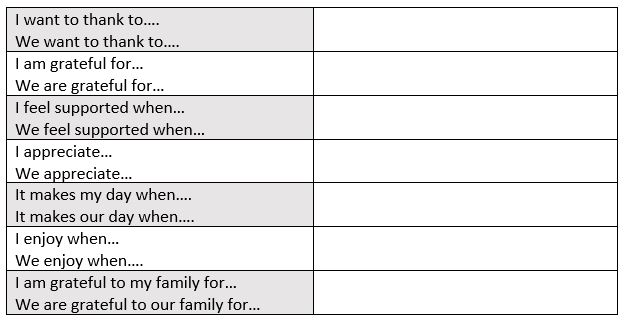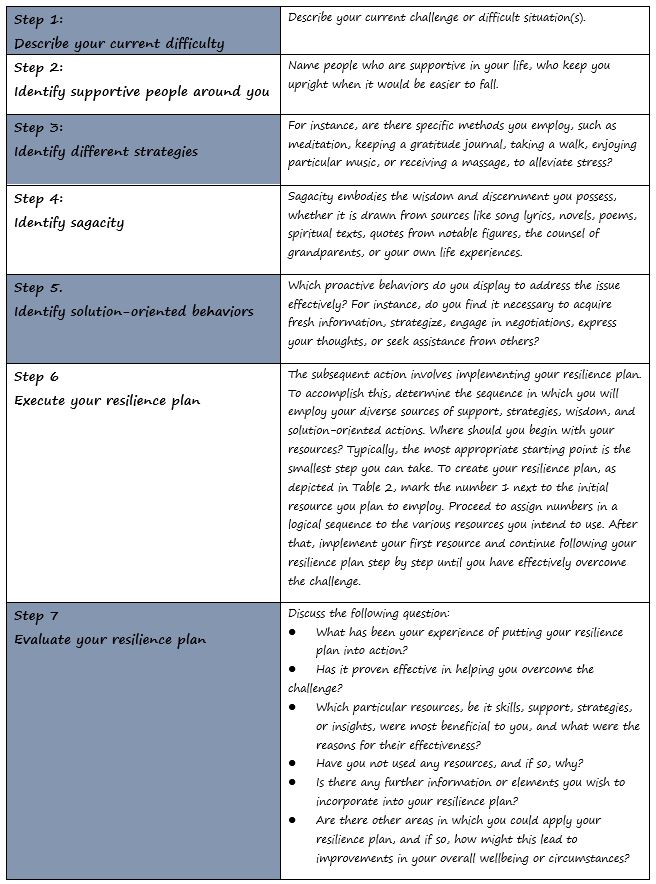By asking these questions written below, it is possible to gain insight into the various parameters that define undesirable psychosocial reactions and stressful conditions in parents. It is also possible to consider how parents assess their strengths and coping strategies, and what their needs are in terms of receiving adequate support.


WHAT MAKES ME FEEL GOOD?
WHAT DO I ENJOY?
WHAT AM I DEPRIVING MYSELF OF?



- Suggestions on how to overcome stressful and challenging situations that may occur in family life
Overcoming stressful situations is very important for healthy family dynamics which represent the base of security and attachment. For this reason, it is essential to encourage parents to understand and accept different attitudes, beliefs and behaviours that can contribute to better family functioning, as follows:
- Explore different viewpoints and contemplate areas of success and potential enhancement.
- Be able to discern both the favorable and challenging aspects of an issue.
- Gain insights from prior experiences to either avert or mitigate the recurrence of similar situations in the future, or to modify the customary reaction to adverse events.
- Engage with the everyday challenges and disruptions that arise in family life. If you extend kindness and self-compassion, you will handle family life with increased patience.
- Establish a schedule with your child, designating specific time slots for both educational activities and play. Particularly in moments of crisis or change, there might be a need for some flexibility in these routines. At the same time, it is important that you maintain a schedule and consistency.
- Empower your child to build trust in their ability to resolve issues and make sound decisions.
- A positive and optimistic outlook can empower children to perceive the positive aspects of life and persevere, even in the face of the most challenging circumstances.
- Change can frequently evoke fear in children and teenagers. Assist your child in recognizing that change is a natural aspect of life, and new aspirations can take the place of goals that may no longer be achievable.
- Strategies to build resilience
PRACTICAL STRATEGIES
- Incorporate enjoyable and healthy activities into your daily schedule. This will rejuvenate you and prevent feelings of exhaustion.
- Prioritize the well-being of your physical and mental health, as it forms the cornerstone for effectively handling the demands of daily life.
- Write a journal - organise your thoughts and experiences. This is an evidence-based strategy for improving coping skills and reducing stress.
- Talk to others who may have advice or strategies that could help you in your situation. Often others who have already overcome the same problem are the best advisors.
- Seek insight in any given circumstance. What valuable lessons can be gleaned from both positive and less favorable results?
- Allow yourself to take a break - reward yourself with something you love and enjoy.
EMOTIONAL STRATEGIES
- Be kind to yourself. Treat yourself as you would comfort and support a close friend who has undergone a similar experience.
- Reach out to others for support, sharing your emotions. Compassionate individuals have the ability to significantly improve our well-being.
- Discuss with a friend. Can he or she provide a different perspective?
- Allow yourself to experience disappointment, sadness, or any other emotion you need to process. If possible, try to confine these emotions to moments when you can manage them effectively; this is a constructive approach for developing self control. If you find it challenging to manage or alleviate stress or intense feelings, don't hesitate to reach out to a friend, a trusted individual, or seek professional assistance.
- Use humour.
PHYSICAL STRATEGIES
- Rest. Give yourself the necessary time to rejuvenate. Your body and mind require rest and approximately 6 to 7 hours of sleep (or more if you're fortunate).
- Deal with your fatigue. If you find yourself lacking in energy, structure your daily activities in a way that aligns your peak energy levels with the most crucial moments.
- Get moving. Be active. Discover an activity that brings you joy, be it hiking, gardening, or yoga. If you can’t fing the time,, formulate a plan to incorporate physical activity into your life in the upcoming days.
- Start meditating, deep breathing, mindfulness, or engage in another form of psychophysical relaxation. Developing the ability to physically soothe yourself offers a multifaceted advantage, promoting emotional, cognitive, and behavioral calmness.
A mood journal can help you to identify and recognise your emotions, and to understand theirs causes and triggers. It also can support you in exploring new and/or different coping skills.

Many times, in our life we are focused on negative experiences. However, life also consists of beautiful and pleasant things. Try to think about what is good and inspiring in your life and what you are grateful for. Perhaps we should remember and appreciate them more often. So, for example, you can personally or together with other family members think about everything you are grateful for and fill in the table below.

TABLE 1. GRATITUDE LIST
- WISH BOARD - VISUALIZE YOUR GOALS AND DREAMS
Create your personal or family vision board that represents your life goals and dreams. It can be a daily reminder of what you are striving for, and a motivator for setting smaller goals and strategies that will make it possible. You can make it on plain paper using different visually art tolls, colours, photographs, drawings, words, poems, quotes, affirmations, etc. The template for the vision board can also be a good idea to give some guidlines (figure 9). Further, you can use some digital version by using a tool like Canva – Free Vison Board Marker (an online editing software) to make a digital vision board that you can make your computer wallpaper or print out.

WISH BOARD
This exercise will help you use your resilience resources to create a personal resilience plan that can help you overcome current or future challenges.
